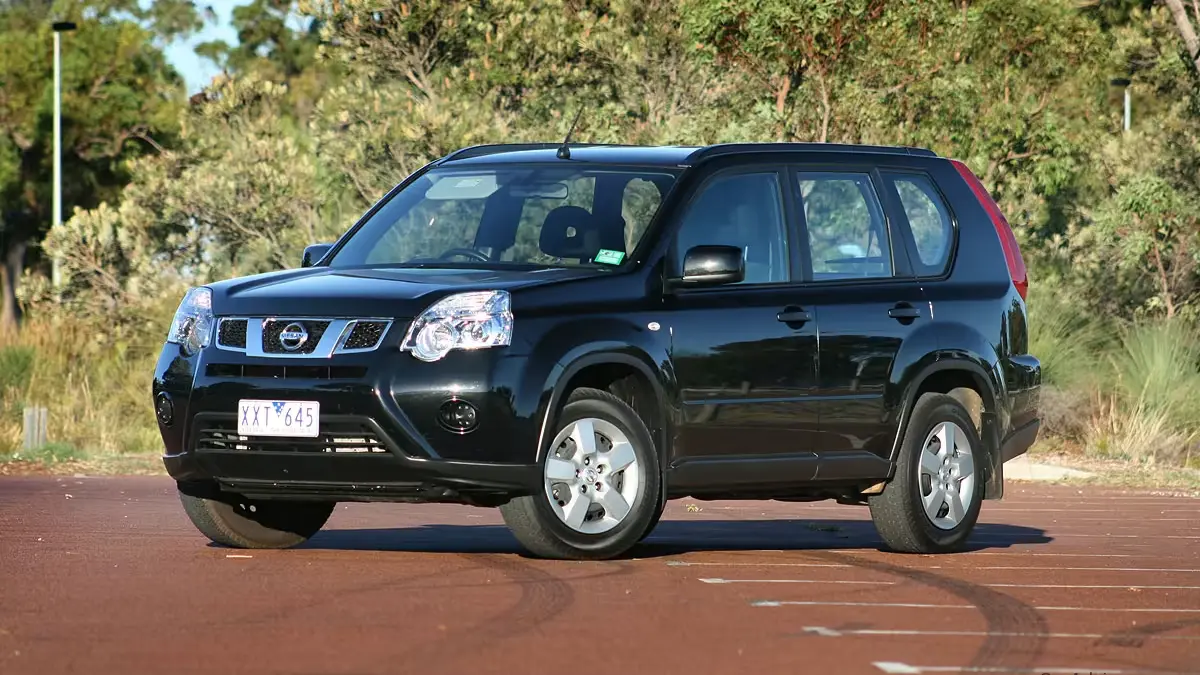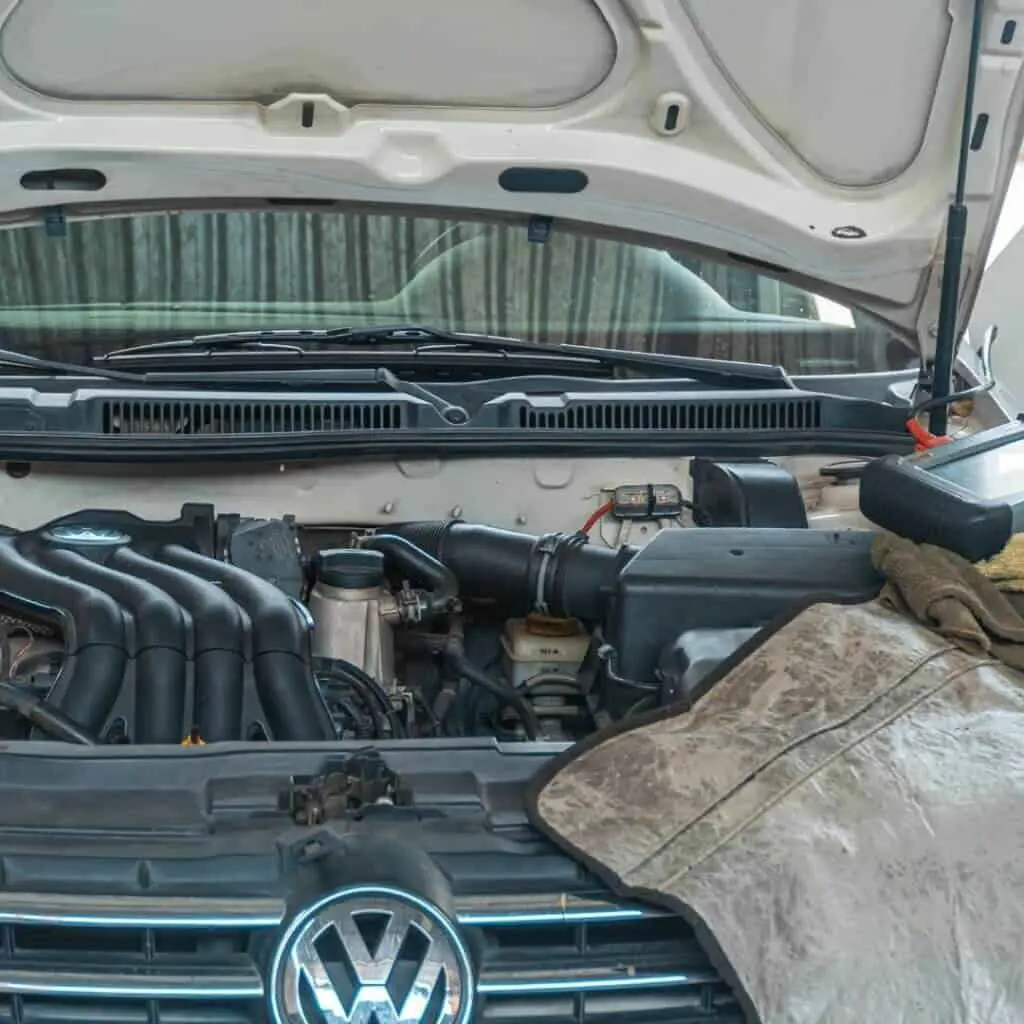Can you recognize Nissan X Trail problems before you buy it?
The Nissan X-Trail is a popular crossover SUV known for its versatility, spacious interior, and reliable performance.
It is also known as the Nissan Rogue in some regional markets. The SUV has a 2.5-liter four-cylinder gasoline engine and outputs 170 horsepower. The vehicle has a CVT, front-wheel drive (FWD), and all-wheel drive options.
The X-Trail has a comfortable seating capacity for five to seven people and a spacious cargo area with a flexible storage system design.
Safety features include airbags, blind-spot monitoring, automatic emergency braking, ABS, stability control, and forward collision warning. However, like any vehicle, the X-Trail is not exempt from encountering problems.
Most Common Nissan X-Trail Problems

Common issues of the Nissan X-trail include engine and turbo problems, issues with DPF, and fuel leaks on early 2000’s models. Other problems include issues with airbags and power steering failure.
- Engine Problems
The Nissan X-Trail is known for its engine problems. A common issue reported with the X-Trail is difficulty starting the engine or frequent stalling.
This problem results from a faulty camshaft, particularly in early models between 2000 and 2002. Defective timing chain tensioners also cause these problems, leading to engine failure [1].
Several owners of the Nissan X-Trail diesel versions have reported problems with their turbochargers. If the turbo breaks, you may experience a whistling sound, excessive black smoke in the exhaust, and a loss of engine power.
This issue affects all models of the X-Trail and requires the complete replacement of the turbocharger. While the replacement is relatively easy, sourcing a suitable turbocharger is crucial to ensure optimal performance.
The car might suffer blown head gasket issues, although these are rare. This might result in the engine coolant leaking into the combustion chamber, causing white smoke in the exhaust and power loss.
Excessive overheating can also result in the deformation of the piston rings, which can be costly to repair.
- Turbo Leaking
Oil leakage from the turbocharger indicates a leaking intercooler. This problem requires the replacement of the intercooler itself. Oil leaking from the intercooler can lead to various issues, including reduced turbocharger efficiency and potential engine damage [2].
Replacing the intercooler is essential to fix the problem. However, it’s worth noting that this repair can be relatively expensive. Therefore, it’s important to consider the cost and weigh it against the value of the vehicle before proceeding.
- Suspension Problems
The Nissan X-Trail suffers from a few suspension problems that have caught the attention of its owners. One of the primary culprits is shock absorber malfunctions. These critical components are responsible for maintaining stability and ensuring a smooth ride.
Excessive bouncing, annoying vibrations, and difficulty controlling the X-Trail indicate that the shock absorbers may require attention. The strut mounts and bushings pose another area of concern. If they wear out or are damaged, they can transform a peaceful drive into a symphony of clunks and bumps.
Be alert to strange noises and rougher rides. These signs could indicate the deterioration of suspension components [3].
As a result, they contribute to increased noise, excessive vibrations, and compromised stability. Replacing them effectively eliminates the knocking noise and restores the smoothness of the suspension.
Once again, the X-Trail has problems with ball joint failures. These vital components connect the suspension elements to the wheels, facilitating smooth movement and precise handling.
However, failing ball joints can rapidly diminish the car’s driving experience. Consequently, immediate attention is imperative to safeguard the integrity of the system.
If you are struggling with suspension issues in your car, it is advisable to seek the expertise of a mechanic or authorized Nissan Service Centre. These professionals possess the necessary knowledge to diagnose the problem and provide the best solution.
Whether it involves repair or replacement, their proficiency will enhance your driving experience [4].
- DPF Warning Light
In diesel X-Trail models produced from 2007 onwards, the Diesel Particulate Filter (DPF) warning light is a common issue. This warning light typically indicates a blocked DPF due to using the vehicle primarily for short journeys [5].
Owners are strongly advised to take their vehicle for a drive on a highway or public road. During this drive, they should maintain an engine speed of approximately 2500 RPM for at least 15 minutes. This action helps increase the DPF’s temperature and facilitates the burning off of collected particles.
If driving fails to resolve the issue, manual cleaning of the DPF may be necessary. Alternatively, seeking assistance from an expert may be required to address the problem.
- Transmission and Gearbox Problems
The Nissan X-Trail is associated with some transmission and gearbox issues. One of the problems reported is shuddering and slipping gears, particularly during takeoff. This is a common problem with CVT transmissions.
It results from a faulty clutch or a damaged mechanism connecting the gear shift to the gearbox [6].
To address this issue, ensure regular changes of the transmission fluid.
Additionally, it is advisable to have the system inspected by a mechanic for any potential problems.
Another issue arises when towing heavy loads since overheating the transmission can cause significant damage. Installing an external transmission oil cooler as a preventive measure when pulling with the X-Trail is recommended.
Although changing the transmission oil has been suggested as a potential fix for specific CVT issues, some problems may result from the transmission’s core programming. Therefore, consulting the Nissan Center for evaluations is advisable to understand these problems better.
- Fuel Leaks
Some Nissan X-Trail owners have experienced fuel leaks, specifically during refueling. A small hole in the filler tube typically causes this issue.
Certain Nissan X-Trail vehicles built between 2000 and 2004 are more susceptible to rust in the filler tube, especially near the mounting bracket. Over time, the rust could form small holes, resulting in fuel leakage [7].
Such leaks pose significant safety risks, including the potential for fire hazards. Inspecting the fuel system occasionally and promptly addressing any indications of rust or leakage is essential.
In most cases, a simple repair using glue can resolve the problem. However, if the rust damage is severe, replacing the entire filler tube may be necessary.
- Power Steering Failure
Power steering failure is a severe issue that Nissan has acknowledged in X-Trails manufactured between August 2008 and August 2011. This problem results from a casting flaw in the power steering control unit, which leads to malfunctioning.
To rectify this issue and ensure the continued safety and performance of the vehicle, Nissan offers free repairs at their authorized dealerships for affected owners.
Promptly addressing power steering failure is crucial. Such failure can significantly impact the vehicle’s drivability and compromise the driver’s and passengers’ safety [8].
In the case of X-Trails produced in 2007, some owners have reported experiencing looser steering than usual, accompanied by excessive noise. This particular problem can be due to a fault in the steering shaft.
When the steering shaft is worn or damaged, it compromises the safety and stability of the vehicle. Taking action to replace the faulty steering shaft is essential for ensuring optimal performance.
- Hazard Lamp Problem
Certain Nissan X-Trail vehicles encountered a significant problem concerning their trailer hazard lamps. This issue was particularly prevalent from March 2007 to April 2008. When towing a trailer, the hazard lamps failed to illuminate, which posed potential safety risks during nighttime driving or in hazardous situations [9].
This issue primarily impacts individuals who frequently tow trailers with their vehicles. Therefore, inspecting and verifying all lighting systems’ functionality thoroughly is crucial. This also includes trailer-related components.
When considering purchasing an X-Trail manufactured from March 2007 to April 2008, conduct a thorough assessment to ensure that the trailer hazard lamps operate correctly to maintain safety on the road.
- Airbag problem
Some Nissan X-Trail vehicles manufactured in August 2001 experienced issues related to their airbags. The problem arose from the combustion rate of the airbag propellant, which could be too fast.
This excessive combustion rate resulted in abnormally high internal pressure during airbag deployment, leading to a scattering of metal fragments [10].
Such an airbag malfunction poses a significant safety risk to occupants during a collision. Verifying that any X-Trail from this period has had the airbag system inspected and potentially repaired or replaced is important.
Read Next: Nissan Qashqai Problems
Conclusion
Although the Nissan X-Trail has its share of problems, proactive maintenance and timely repairs can alleviate most issues and provide a rewarding ownership experience.
Most common Nissan X-trail problems include engine, turbo, dpf, hazard lamp problem, etc.
Potential buyers can mitigate problems and make informed decisions by staying informed about recalls and conducting thorough inspections before purchasing the Nissan X-Trail.
Remember to follow the manufacturer’s recommended maintenance schedule to guarantee your car’s reliability and performance over the long term.
Additionally, addressing problems promptly and seeking expert assistance can extend the vehicle’s lifespan. The Nissan X-Trail can surpass an average of 200,000 kilometers with proper care.
Read Also: Nissan Juke Problems





